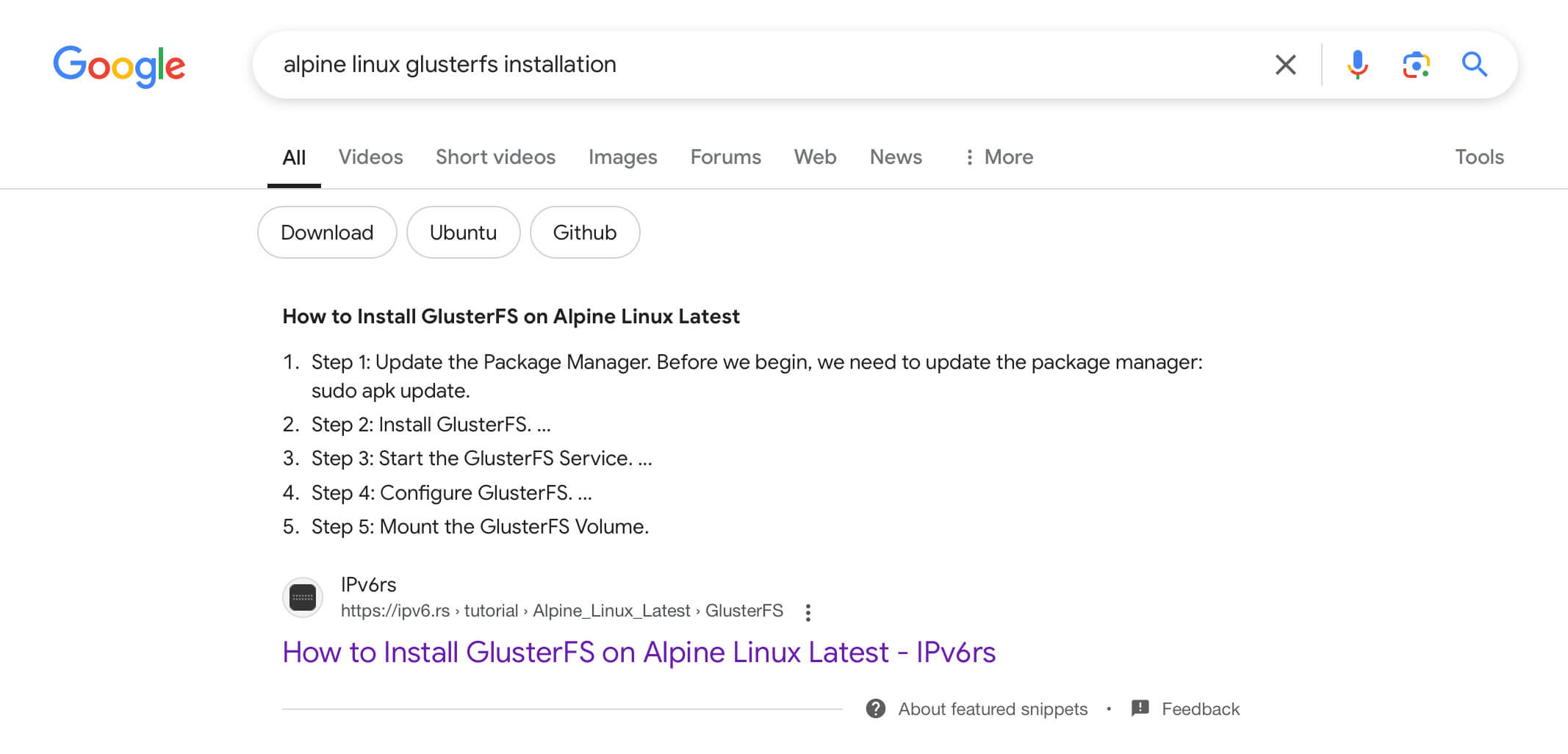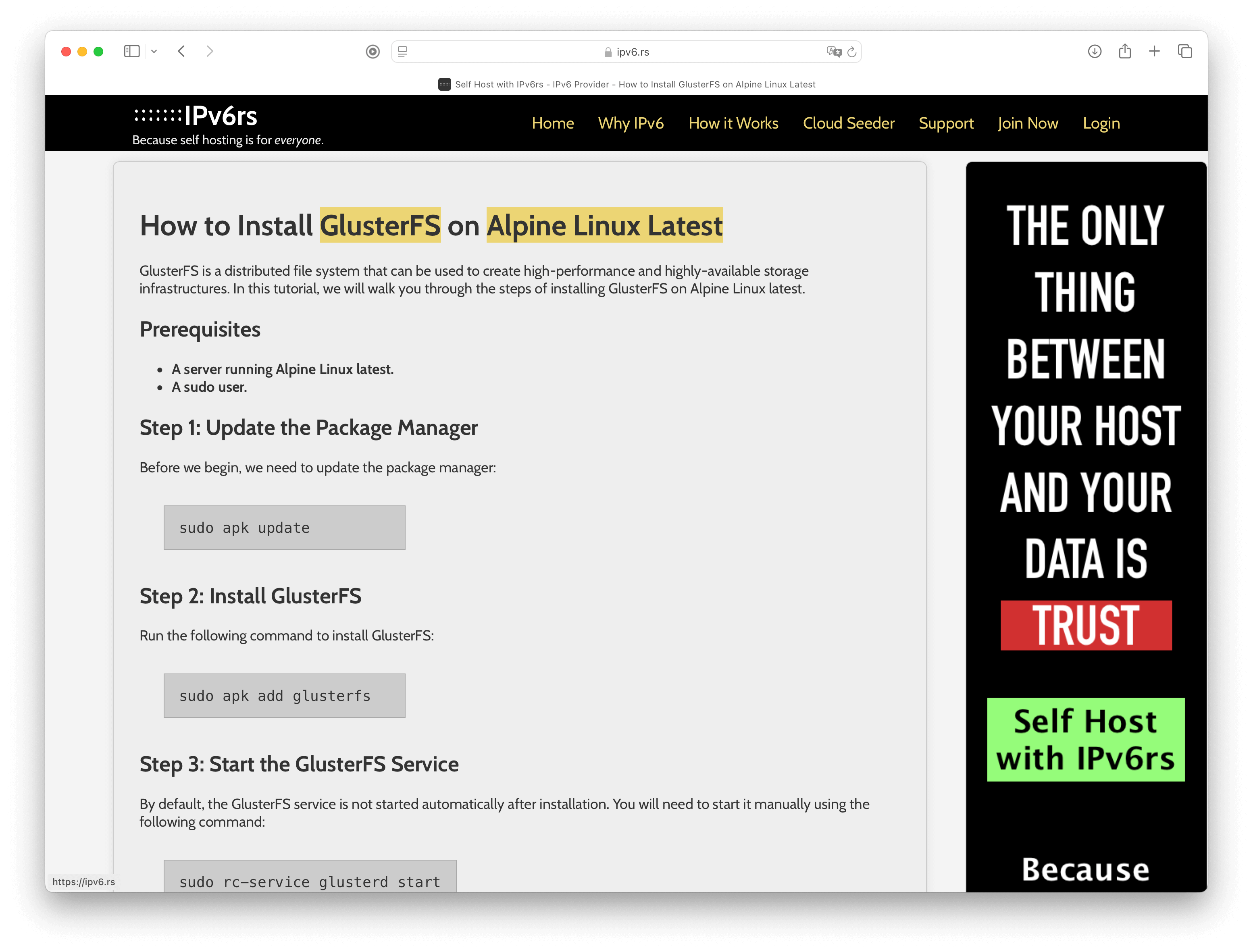Call me old-fashioned, but I do like googling my results like it’s 2010. Not summoning some aspiring AI daemon that could use up to 40 Watt hours per query at a sixth of Google’s valuation. Although I won’t need much imagination to assume that good-ol’-googl will also happily add cruft to an otherwise trivial vector search whenever technically possible.
Speaking of wasting energy, I’m currently interested in setting up some local on-demand Linux cluster with generally low overhead. For that, I also need a cluster file system with low management requirements and relatively high throughput. The cluster is built around Alpine Linux, my favorite Linux distribution.
After some research on Google, surprisingly with good yet ancient content from Reddit, I realized GlusterFS could be a viable solution. It is quite mature, some say it’s barely alive, especially after (thankfully unfounded) concerns that Fedora would stop packaging it.
But GlusterFS seems to do what I need without having to hire a full-time storage admin like I probably would for Ceph.
I might also miss out on some cool features of SeaweedFS, but then I don’t have to worry about actually hiring a full-time database admin because SeaweedFS simply throws the problem of maintaining metadata over to a third-party database — its default memory storage is “for testing only, no persistent storage”…
So, GlusterFS it is for now… Let’s check it out. But how do I test GlusterFS on my Alpine Linux system?
Given that I have never used it, let alone know how to configure it, my first reaction is to search Google for something like “alpine linux glusterfs installation”.

As always, Google happy obliges with blue links, and this time, with a featured snippet. Featured must mean good.
I click on the link, and land on a tutorial page of some “ipv6.rs” self-hosting provider. That sounds like it’s a trustworthy site for people building clusters, right?
Of course, it not only sounds like it, but it also says it on the right side of the page, in large letters:

That means, by definition, it’s trustworthy all right. And it’s not that the instructions would seem odd; they are exactly what I was looking for. Although the details are a little light. But: they are a starting point.
So I fire up a busybox shell on Alpine Linux, type in apk add glusterfs, as instructed, only to get the following error:
1
2
3
ERROR: unable to select packages:
glusterfs (no such package):
required by: world[glusterfs]
See, the thing is, that package doesn’t exist, and our “tutorial” website is just automatically generated AI slop. It’s almost exactly what you get from Perplexity’s answer to the question.
Interestingly, you get a similar answer from OpenAI’s ChatGPT — if you use their free version without a login. If you do login, you get an entirely different blurb, with something like:
As of now, there isn’t an official GlusterFS package available for Alpine Linux. Attempts to compile GlusterFS on Alpine have encountered difficulties, primarily due to dependencies on glibc-specific functions that musl does not support.
That’s a more accurate answer, although anyone can blame Alpine’s affinity with musl, because it’s so much easier than fixing your non-portable glibc code. And then of course everyone has already forgotten how the xz utils backdoor story completely passed by Alpine Linux without any security impact…
But I digress. Back to our “search results veracity issue”.
You could say, well the models get better, as you can see from the new model OpenAI has when you login.
I say, I liked the first answer better, even though I despise its inherent falsity.
So what is the only logical, reasonable thing one can do in this situation? Well, of course, I spent a few days on it (admittedly not counting my energy consumption), and — voilà — now we can compile and use Gluster on Alpine Linux 3.21!
You can find my GlusterFS fork here, issue tracking (the oldest still-open ticket in GlusterFS) is here. Oh yeah, and I also added snapshotting support for BTRFS to GlusterFS, because why not.
What’s especially nice: if you enable my custom Alpine Linux repository, all the instructions from the “ipv6.rs” tutorial work as if they were true answers. It’s unbelievable how well simple models work if you just give them a little help from a human.
Who needs that new shiny OpenAI GPT-5 now? Back to the roots. Stick it to the man!